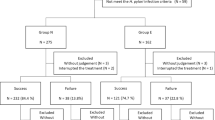Abstract
Raynaud's phenomenon is defined by anintermittent vasospasm of the arterioles of the distallimbs. Helicobacter pylori infection has been recentlyassociated with Raynaud's phenomenon. The aim of this study was to assess the effects of H. pylorieradication on Raynaud's attacks. Forty-six patientsaffected by primary Raynaud's phenomenon were evaluated.H. pylori infection was assessed by [13C]urea breath test. Eradication therapy was given toinfected patients for seven days. Discomfort and theduration and frequency of attacks of Raynaud'sphenomenon per week were assessed. Thirty-six subjectswere infected with H. pylori; the bacterium waseradicated in 83% of these after therapy. Attacks ofRaynaud's phenomenon completely disappeared in 17% ofthe patients with H. pylori eradication. Discomfort and the duration and frequency of attacks ofRaynaud's phenomenon were significantly reduced in 72%of the remaining patients. Conversely, attacks ofRaynaud's disease did not change significantly during the 12-week follow-up period either in the H.pylori-negative patients or in the infected subjects inwhom the bacterium was not eradicated by therapy. Thestudy shows that H. pylori eradication causes a significant decrease in clinical attacks ofRaynaud's disease. The reduction of vasoactivesubstances determined by the eradication of thebacterium may be the pathogenetic mechanism underlyingthe phenomenon.
Similar content being viewed by others
REFERENCES
Calam J: Helicobacter pylori.Eur J Clin Invest 24:501-510, 1994
Gasbarrini G, Pretolani S, Bonvicini F, Gatto MRA, Tonelli E, Megraud F, et al: A population based study of Helicobacter pyloriinfection in a European country: The San Marino Study. Relations with gastrointestinal diseases. Gut 36:838-844, 1995
Gasbarrini A, Franceschi F, Gasbarrini G, Pola P: Extraintestinal pathology associated with Helicobacterinfection. Eur J Gast Hepatol 9:231-233, 1997
Mendall MA, Patel P, Carrington D, Strachan D, Leatham E, Molineaux N, Levy J, Blackstone C, Saymour CA, Camm AJ, Northfield TC: Association of Helicobacter pyloriand Chlamydia pneumoniaeinfection with coronary heart disease and cardiovascular risk factors. Br Med J 311:711-714, 1995
Morgando A, Sanseverino P, Perotto C, Molino F, Gai V, Ponzetto A: Helicobacter pyloriseropositivity in myocardial infarction. Lancet 345:1380, 1995
Mendall MA, Goggin PM, Molineaux N, Levy J, Toosy T, Strachan D, Camm AJ, Northfield TC: Relation of Helicobacter pyloriinfection and coronary heart disease. Br He art J 71:437- 439, 1994
Miragliotta G, Del Prete R, Mosca A: Helicobacter pyloriinfection and coronary heart disease. Lancet 344:751, 1994
Gasbarrini A, Serricchio M, Tondi P, Gasbarrini G, Pola P: Association of Helicobacter pyloriinfection with Raynaud phenomenon. Lancet 348:966-967, 1996
Crabtree JE: Immune and inflammatory responses to Helicobacter pyloriinfection. Scand J Gastrenterol 31(suppl) 215:3- 10, 1996
Crabtree JE, Shallcross TM, Heatley RV, Wyatt JL: Mucosal tumor necrosis factor alpha and interleukin-6 in patients with Helicobacter pyloriassociated gastritis. Gut 31:1473-1477, 1991
Maseri A, Biasucci LM, Liuzzo G: Inflammation in ischaemic heart disease. Br Med J 312:1049-1050, 1996
Mendall MA, Patel P, Ballam L, Strachan D, Northfield TC: C reactive protein and its relation to cardiovascular risk factors: A population based cross sectional study. Br Med J 312:1061- 1065, 1996
Yoshida N, Granger DN, Evans DJ, Graham DY, Anderson DC: Mechanism involved in Helicobacter pylori-induced inflammation. Gastroenterology 105:1431-1440, 1993
Kurose I, Granger DN, Evans DJ, Evans DG, Graham DY, Myiaska M, Anderson DC: Helicobacter pylori-induced microvacular protein leakage in rats: Role of neutrophils, mast cells and platelets. Gastroenterology 107:70-79, 1994
Lancon B, Pistorius MA, Beurier P, De Faucal P: Primary Raynaud's phenomenon. Age of onset and pathogenesis in prospective study of 424 patients. Angiology 45:677-686, 1994
Pistorius MA, Planchon B, De Faucal P: Plethysmographic cold test for diagnosis and evaluation of the severity of Raynaud's phenomenon. Int Angiol 13:10-13, 1994
Wigley FM, Wise RA, Seibold JR, McCloskey DA, Kujala G, Medsger TA Jr, et al: Intravenous Iloprost infusion in patients with Raynaud phenomenon secondary to systemic sclerosis. A muticenter, placebo-controlled, double-blind study. Ann Intern Med 120:199-206, 1994
Logan RPH: The 13C urea breath test. In Helicobacter pylori: Technique for Clinical Diagnosis and Basic Research. A Lee, F Megraud (eds). London, Saunders 1996, pp 74-81
Lanza FL: Endoscopic studies of gastric and duodenal injury after the use of ibuprofen, aspirin and other non steroidal anti-inflammatory agents. Am J Med 77:19-24, 1984
Zhang QB, Nakshabendi IM, Mokhashi MS, Dawodu JB, Gemmel CG, Russel RI: Association of cytotoxin production and neutrophil activation by strains of Helicobacter pyloriisolated from patients with peptic ulceration and chronic gastritis. Gut 38:841-884, 1996
Yamaoka Y, Kita M, Kodama T, Sawai N, Tanahashi T, Kashima K, et al: Role of chemokines in gastric mucosa with Helicobacter pyloriinfection. Gut 39(suppl):A60, 1996
De Koster E: Microbiological aspects of Helicobacter pylori. Eur J Gastroenerol Hepatol 5:S33-S35, 1993
Ahmed A, Holton J, Vaira D, Smith SK, Hoult JRS: Eicosanoid synthesis and Helicobacter pyloriassociated gastritis: Increase in leukotriene C4 generation associated with H. pyloricolonization. Prostaglandins 44:75-86, 1992
Bierti L, Cernuschi C, Abbiati C, Beccari G, Di Battista R, Marchi R, et al: Correlation between gastric infection with Helicobacter pyloriand plasma levels of fibrinogen, plasminogen activator inhibitor (PAI), and von Willebrand factor (vWF) antigen. Gut 39(suppl):A90, 1996 (abstract)
Parente F, Imbesi V, Maconi G, Rossi E, Bianchi Porro G: Is Helicobacter pylori(HP) infection associated with a tendency towards a procoagulant state in healthy individuals? Gut 39:A93, 1996 (abstract)
Nieminen MS, Mattila K and Valtonen V: Infection and inflammation as risk factors for myocardial infarction. Eur He art J 14(suppl):12-16, 1993
Negrini R, Savio A, Poiesi C, Appelmelk BJ, Buffoli F, Paterlini A, et al: Antigenic mimicry between Helicobacter pyloriand gastric mucosa in the pathogenesis of body atrophic gastritis. Gastroenterology 111:655-665, 1996
Fujiwara Y, Yamanaka O, Nakamura T, Yamaguchi H: Coronary spasm in two sisters. Jpn Circ J 57:472-474, 1993
Rights and permissions
About this article
Cite this article
Gasbarrini, A., Massari, I., Serricchio, M. et al. Helicobacter pylori Eradication Ameliorates Primary Raynaud's Phenomenon. Dig Dis Sci 43, 1641–1645 (1998). https://doi.org/10.1023/A:1018842527111
Issue Date:
DOI: https://doi.org/10.1023/A:1018842527111




